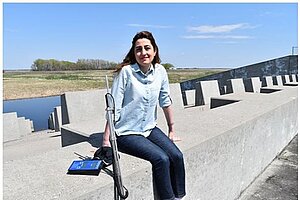Impacts of Climate Change on Embankment Dams in the Upper Midwest Region: Critical Design Parameters and Adaptation Measures

Bahareh Shoghli
Fellow: Bahareh Shoghli
Adviser: Yeo Howe Lim
Impacts of Climate Change on Embankment Dams in the Upper Midwest Region: Critical Design Parameters and Adaptation Measures
Dams are the most important component of water resource systems found in many places. Water is stored and regulated by dams such that the development objectives of water supply, agriculture, manufacturing industry, energy generation, and other sectors are met. The impacts of climate change on the water resources distribution has been projected as one of the major problems in the next fifty years (U.S. Global Change Research Program, 2000). However, the adaptations to mitigate the changes still seriously lacking in many critical infrastructural systems. Embankment dams are very common in the U.S., hence a large number of these dams will be affected should there be a change in the climate regime.
Climate change can affect the dams and their performance through alterations of the hydrologic cycle. In an extreme scenario, warmer temperature accompanied by more precipitation could lead to larger snowpack and earlier spring melting of snowpack, which could increase the elevation of runoff in the basin. Conversely, lower temperatures accompanied by lesser precipitation could decrease the snowpack and delay the spring melting of the snowpack, which in turn, could lead to a reduction in the runoff within the basin. Both these extreme scenarios, along with other climate-change scenarios, could alter the basin water balance spatially and temporally. Sedimentation is an on-going natural process that will reduce the life-span of dams. Given the possibilities of an induced change in the hydrologic cycle, the rate of sedimentation will certainly be affected. In the assessment of climate change, three critical change factors are to be considered: (1) the magnitude and variability of rainfall and streamflow, (2) the magnitude and severity of extreme flood and storm events, and (3) the changes in vegetation and land use.
Many dams were designed and built at the beginning of the last century. Some specific questions to be answered would include: (1) how would the dams perform under a possible new climate regime. (2) to what extent is the safety of the dams being compromised under the new hydrologic regimes? (3) how the induced changes in the sedimentation rate in the basin may influence the operation of dams in return to the dam safety issue?
Significance of Research
Climate change can affect the dams and their performance through alterations of the hydrologic cycle. Warmer temperature accompanied by more precipitation could lead to larger snowpack and earlier spring melting of snowpack, which could increase the flood peaks in the basin. Conversely, lower temperatures accompanied by lesser precipitation could decrease the snowpack and delay the spring melting of the snowpack, which in turn, would lead to a decrease in peak discharges within the basin. Both scenarios, along with other climate-change scenarios, could alter the other basin-runoff associated processes. Reservoir sedimentation is a complicated process that depends on the watershed sediment production, flood frequencies, reservoir geometry and operation flocculation potential, sediment consolidation, density currents, and land use changes over the life expectancy of the reservoir. Accumulated sediment behind the dams can affect the flood attenuation function of the reservoir. As a result, the ecosystem of the river will change. Understanding the sediment dynamics and identifying the main effective parameters on erosion of soil are necessary to optimize the strategies for minimizing sediments entrance. Prediction of sediment deposition is always needed in the planning, design and operation stages of reservoir.
Significant Findings
Construction of a dam leads to the creation of an artificial reservoir, which normally decreases the flood peak discharge downstream of the dam. However, climate change will increase the magnitudes of extreme flood peak events generated by hydrologic processes at the upper watershed, which may result in an increased probability of overtopping the dam. In the first step of this study, ArcSWAT model was established for Sheyenne-Lake Ashtabula watershed area and the calibration- validation of hydrologic runoff from the watershed was performed using SWAT-CUP. Statistical results in terms of NSE and PBIAS have allowed us to infer our simulation as in the category of “good simulation.” Because of the special climatic conditions in North Dakota, there are discrepancies among observed and simulated data during a few extreme spring-melt events. Artificial neural networks were employed to improve the deficiencies of the software used in modeling the snowmelt process.
Publication
Shoghli, B.; Y.H. Lim; J. Alikhani, 2016, Evaluating the Effect of Climate Change on Design Parameters of Embankment Dams Using Remote Sensing:Data Case. in World Environmental & Water Resources Congress 2016, American Society of Civil Engineers, Reston, VA.

Lim Yeo Howe
Civil Engineering
Upson Hall II Room 260D
243 Centennial Drive Stop 8115
Grand Forks, ND 58202-8115
Phone: 701-777-3998
Email: yeo.lim@und.edu


